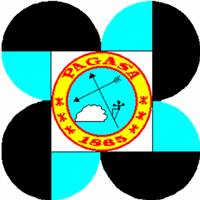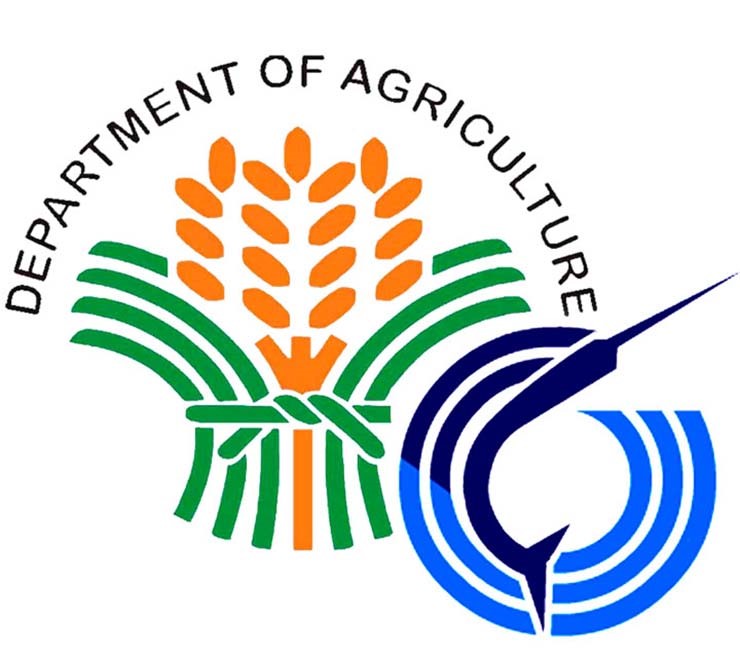Marine Mammal Research & Conservation Laboratory











Goals
The Marine Mammal Research & Conservation Laboratory’s (MMRCL) main goal is to study marine mammals in the Philippines in general and specifically marine mammal strandings. The MMRCL examines the various aspects of the biology (e.g. life history parameters), ecology, conservation and management of these understudied and undervalued groups of animals in the Philippines. This also includes assessing their habitats, threats and conservation status. Also, the MMRCL embraces the One Health view and recognizes the importance of marine mammals as valuable sentinels of ocean and human health. For this reason, the MMRCL works closely with the Philippine Marine Mammal Stranding Network Inc. (PMMSN). The MMRCL also studies the other similarly long-lived and prone to over-exploitation large marine vertebrates such as sea turtles and sharks.
Research Thrusts

Ecology
Description: MMRSL conducts assessment and monitoring of marine mammal & other megafauna (i.e. sharks, rays and sea turtles) populations in the Philippines. Other research studies employ a combination of various land- and boat-based sampling techniques. Distance sampling and photo-identification techniques for marine mammals are used to describe distribution and estimate population density and relative abundance. Data gathered through time from photo-identification, for instance, can help explain the recruitment and survivorship of individuals in a population. Moreover, environmental factors are also investigated in relation to the spatiotemporal distribution and abundance of marine mammals and other megafauna.
Past Projects
- Dugong ecology and conservation in Busuanga and Guimaras;
- Selected ecological aspects of spinner dolphins in southern Tañon Strait;
Current Research Project:
- Ecology and conservation of marine mammals in southern Tañon Strait ;
- Spatiotemporal distribution and relative abundance of small cetaceans along southern Tañon Strait in relation to environmental factors
- Distribution of remaining dugong population in the country

ecotoxicology
Description: Highlighting the potential of marine mammals to indicate ecosystem and human health risks, links between their levels of persistent pollutant contamination, particularly PCBs and their metabolites, and histopathologies are being elucidated. While the immediate concern is to gather chemico-toxic/histopathologic data of stranded marine mammals found in the Philippines, the ultimate objective is to point out on how anthropogenic activities are compromising the marine environment.
Past Research Project:
- Integrating ecotoxicological and hispathological information to understand the effects of PCBs including its metabolites in stranded and bycaught cetaceans found in the Philippine waters
Current Research Project:

microbiology
Description: To elucidate the link between human and ocean health, cetaceans are used as sentinels for indicating a marine environment compromised by biological pollution. This specific field requires microbiological work that involves isolation, identification and profiling of microorganisms present in stranded cetaceans. The first study conducted in the Marine Mammal Research and Stranding Laboratory that involved microbiological work recorded Toxoplasma gondii and other interesting human pathogenic bacteria from stranded cetaceans in the Philippines. Current studies are looking into isolation and antibacterial profiling of Leptospira spp., Enterobacteriaceae and Non-Enterobacteriaceae from stranded cetaceans in the Philippines.
Past Project:
Current Research Project:
- Antibacterial susceptibility of microorganisms isolated from Stranded Cetaceans in the Philippines

Stranding
(Rehabilitating a stranded marine mammal)
Description: One of the focal research areas of MMRSL is on stranded marine mammals. The MMRSL is the research arm of the PMMSN focusing on data collection, rescue, rehabilitation, archiving and detailed examination of stranded marine mammals along the Philippine coast. The data collected through strandings has been utilized to analyze trends and status, distribution, mortality, occurrence and movement patters (to name a few) of marine mammal populations in the country. In addition, the samples (including tissues) collected and archived can be utilized to understand these strandings (see below). MMRSL is currently looking at the relationship of marine mammal stranding with some environmental factors. Information that can be provided by stranding data can be a valuable tool for the conservation and management of marine mammals in the Philippines.
Past Research Project:
- Spatio-temporal analyses of marine mammal stranding in the Philippines
Current Research Projects:
- Maintaining the Marine Mammal Stranding Database of the Philippines
- Marine Mammal Stranding Along Hotspots of the Philippines from 2005 to 2016: Analysis of Association with Environmental Parameters
Medical Management Training for Stranded Marine Mammals held at MMRSL-IESM
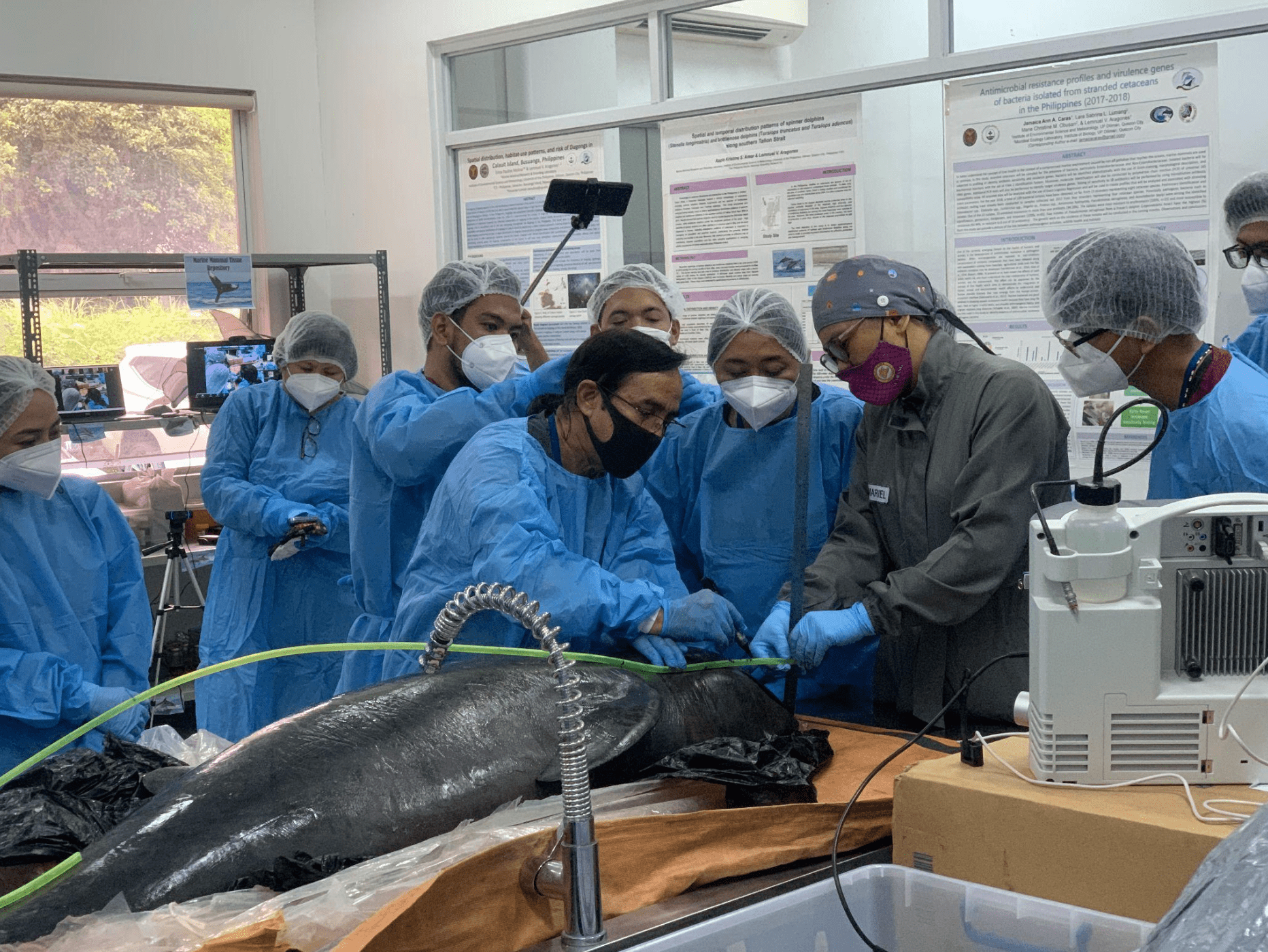 |
The Marine Mammal Research & Stranding Laboratory of IESM together with the PMMSN hosted a hybrid (F2F and virtual) Medical Management for Stranded Marine Mammals: Clinicopathologic, Diagnostic Imaging and Necropsy Training last September 5 to 6, 2022. A select 22 veterinarians throughout the Philippines participated in the F2F mode while the rest of the other 30 vets were engaged virtually. The main objective of the training was to increase the capacity of local veterinarians in conducting medical management and postmortem examination of stranded marine mammals in the Philippines. This training involved both lectures and hands-on components. The lectures focused on the current research on stranded marine mammals in the Philippines, investigating cause of death (natural or anthropogenic), primer on acoustic trauma, diagnostic imaging and endoscopy, age estimation using pectoral fin radiography, case presentations, and results of student theses. The hands-on event involved the necropsy of an Irrawaddy dolphin that stranded in Calabanga, Camarines Sur last August 16, 2022. Also, exercises on endoscopy and ultrasound were performed in the actual carcass. The main trainers included Dr Christopher Torno, Dr Leo Suarez, Dr Emilia Lastica, Dr Mariel Buccat, Dr Christine Obusan, and Dr Lem Aragones. This training was organized and implemented by the PHLMarMams DOST-PCAARRD funded project of MMRSL-IESM. |
 |
 |
 |
 |
 |
Latest Simultaneous Dugong Monitoring in Calawit Show Promising Results
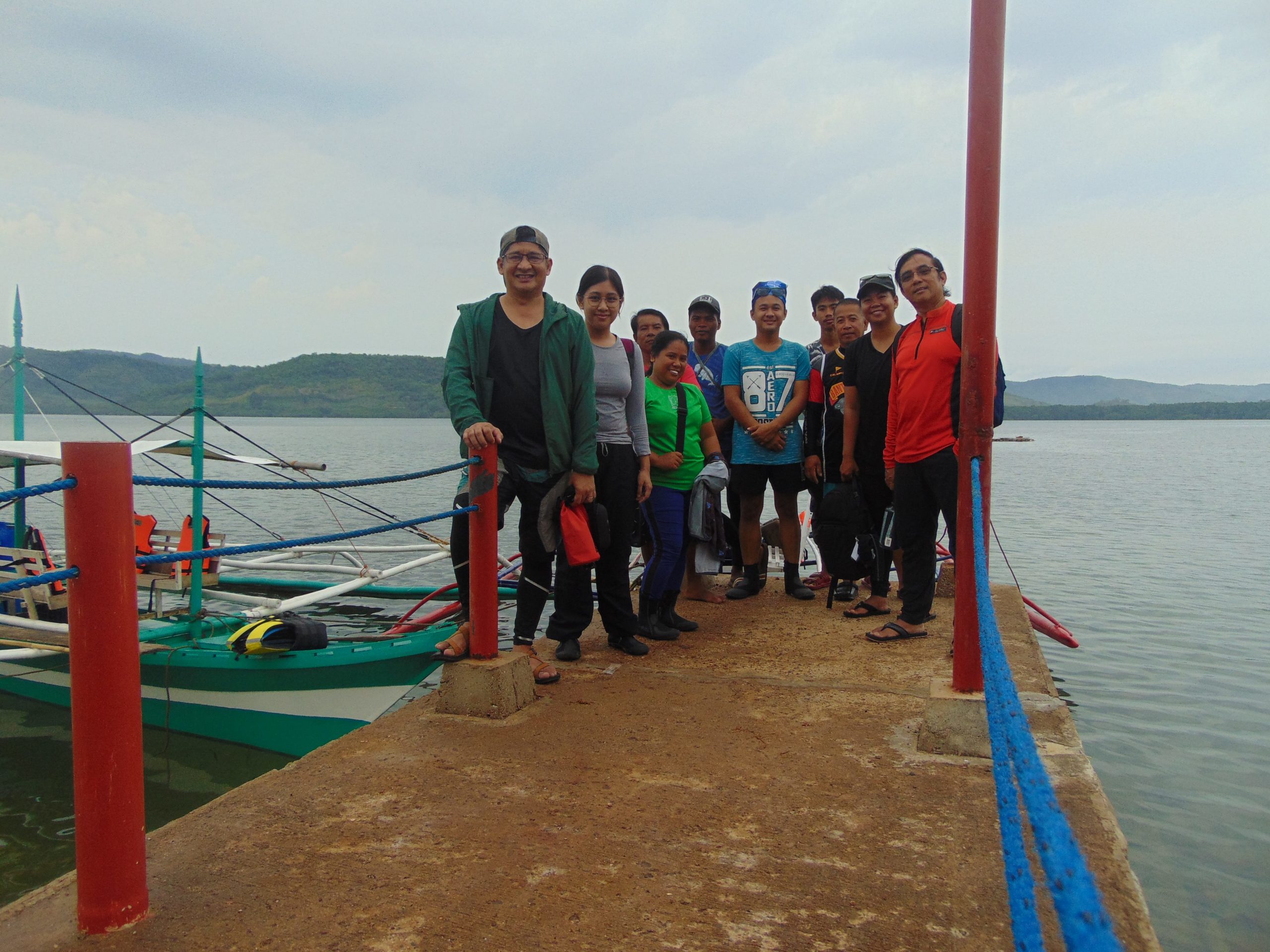
UP-IESM through its Marine Mammal Research & Stranding Laboratory (MMRSL), together with C3-Philippines conducted its yearly Simultaneous Dugong Monitoring (SDM) activity from 18 to 19 June 2022 in Calawit Island, Busuanga, Palawan. Sixty-eight (68) local volunteers from Bantay Dugong, Nurutan Yang Calamian Tagbanua Yang Calawit May Quezon (NTCQ) councils, and Busuanga Eco-Warriors participated as observers (citizen scientists) in the activity.

From 6 AM to 6 PM, at least two observers were stationed on 33 elevated platforms to sight dugongs along the coasts of Calawit including mainland Calawit and two offshore islands - Dimipac and Maltanobon. Dugongs were sighted across the northern, eastern, and western sections of Calawit. Mother and calf pairs were sighted in the southwest and southeast sections of Calawit Island. This yearly activity with the Tagbanwa community ensures the participatory management process for the protection and conservation of the critically endangered dugong. This annual SDM started in 2017. Due to the COVID restrictions, there was no SDM conducted in 2021.

This year’s SDM was funded by the DOST-PCAARRD – PHL MarMams project, and C3-PH and the Marine Conservation Action Fund for the development of the citizen science side.
Latest Small Cetacean Surveys in the Southern Tañon Strait Protected Seascape (TPSP)
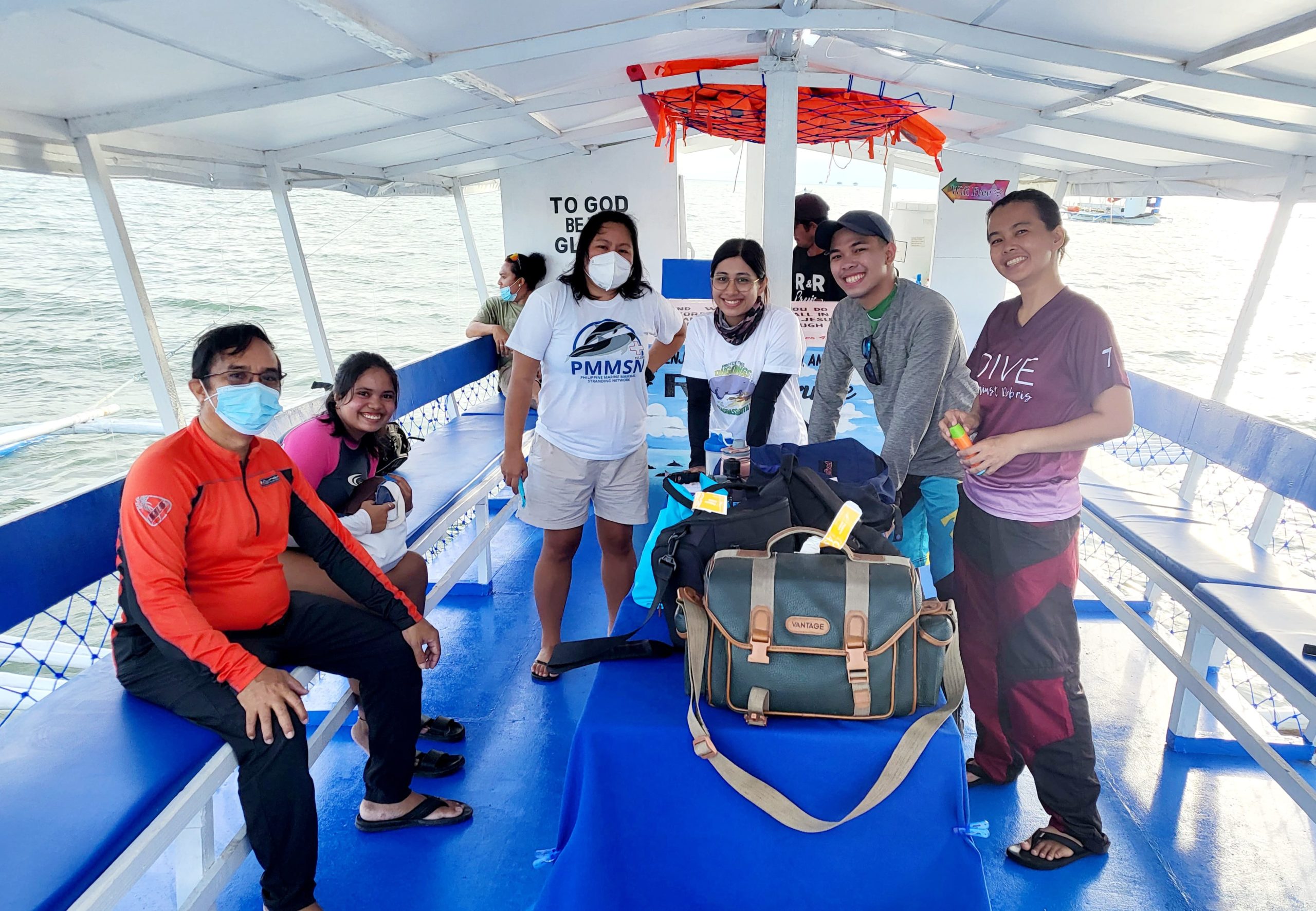
Last July 21-24, 2022, UP-IESM through its Marine Mammal Research & Stranding Laboratory (MMRSL) conducted boat surveys for small cetaceans in the southern Tañon Strait Protected Seascape (TPSP) under its DOST-PCAARRD funded project "Assessment and mobilization of research initiatives on Philippine marine mammals (PHL MarMams)”.






A total of 32 hours was spent at sea aboard a local dolphin-watching boat. The survey covered a total area of approximately 80 km2 located within the waters of Bais City-Tanjay City to Manjuyod on the Negros side, and Alegria-Malabuyoc to Ginatilan on the Cebu side. Photographs of cetacean dorsal fins were continuously captured upon sighting of herds or individuals per species for photo ID and eventual population estimation through mark-recapture techniques. Two races of spinner dolphins, melon-headed whales, pantropical spotted dolphins, and dwarf sperm whales were sighted in this year's survey. Some of the dolphins exhibited evasive behavior during the surveys which is likely a response to stress. Based on rough estimation, there is a reduction in cetacean group sizes and possibly even the actual population. The need to continuously monitor small cetaceans in the TPSP is vital for the protection and conservation of cetaceans in the area.
Irrawaddy Dolphin Found Dead in Bicol
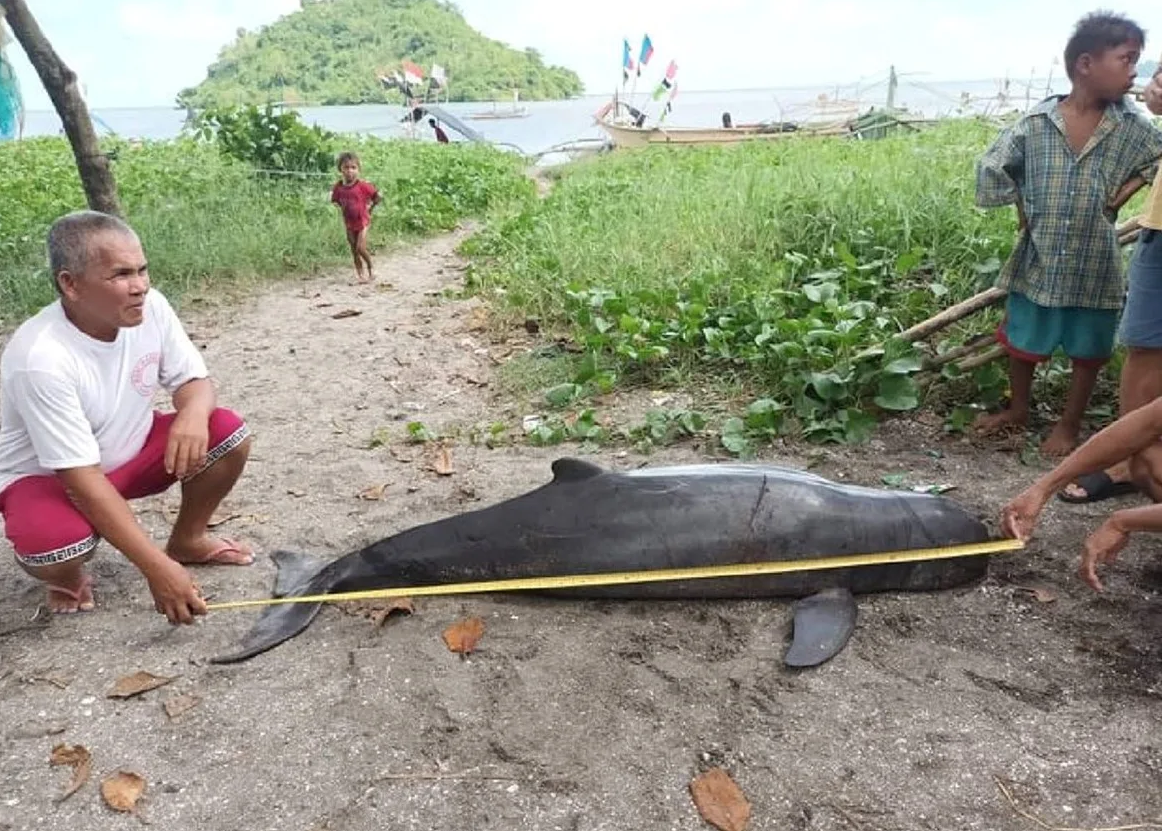
First sighting of the Irrawaddy dolphin in Bicol was confirmed by Dr. Lemnuel V. Aragones. The female sub-adult dolphin was found dead on August 16, 2022, along the coast of Calabanga town, Camarines Sur. Bicol region is one of the only three areas (including Region 6 and Malampaya Sound) in the Philippines where the species is documented to occur. Read more.
Current
- Guzman, Raphael & Aragones, Lemnuel & Obusan, Christine. (2020). Molecular detection of Toxoplasma gondii in select cetaceans stranded in the Philippines in 2019. 13. 206-214.
Link: https://www.researchgate.net/publication/348613204...
- Obusan, Christine & Caras, Jamaica & Lumang, Lara & Calderon, Erika & Villanueva, Ren & Salibay, Cristina & Siringan, Maria A & Rivera, Windell & Masangkay, Joseph & Aragones, Lemnuel. (2020). Bacteriological and histopathological findings in cetaceans that stranded in the Philippines from 2017 to 2018. 10.1101/2020.11.30.403568.
Link: https://www.biorxiv.org/content/10.1101/2020.11.30.403568v1
- Aragones, L.V. & Laggui, H.L.M. (2019). Marine Mammal Strandings in the Philippines from 2017 to 2018: Initial biennial analysis. A PMMSN Publication. Technical Report No. 2. Quezon City, Philippines. 139 pages
Link: https://www.researchgate.net/publication/337945875...
- Obusan, M.C.M., Villanueva, R.M.D., Siringan, M.A.T., Rivera, W.L., Aragones, L.V. (2019). Leptospira spp. And Toxoplasma gondii in stranded representatives of wild cetaceans in the Philippines. BMC Veterinary Research, 15 (1), Article number 372.
Link: https://bmcvetres.biomedcentral.com/articles/10.1186/s12917-019-2112-5
- Suarez, L.J.A., Paz, J.I, Balquin, J.T. & Aragones, L.V. (2019). Haematological and serum biochemical reference values extrapolated from rehabilitated stranded spinner dolphins (Stenella longirostris). Philippine Journal of Veterinary Medicine, 56(2), 1-8.
Link: https://www.researchgate.net/publication/339140253...
- Smith, A. B., Pacini, A. F., Nachtigall, P. E., Laule, G. E., Aragones, L. V., Magno, C., & Suarez, L. J. (2019). Transmission beam pattern and dynamics of a spinner dolphin (Stenella longirostris). The Journal of the Acoustical Society of America, 145(6), 3595-3605. doi:10.1121/1.5111347
Link: https://doi.org/10.1121/1.5111347
- Obusan, Christine, Aragones, Lemnuel, Rivera, Windell & Siringan, Maria A. (2018). Antibiotic Susceptibility Patterns of Bacteria Isolated from Cetaceans Stranded in the Philippines. Aquatic Mammals. 43. 568-579. 10.1578/AM.44.5.2018.568..
Link: https://www.researchgate.net/publication/327669761...
- Bondoc, J. L., Masangkay, J. S., & Aragones, L. V.. (2017). Hematological, Macroscopic and Microscopic Findings in Two Stranded Whales (Mesoplodon densirostris and Kogia sima) and Possible Causes of Deaths. Philippine Journal of Veterinary Medicine, 54(1).
Stranded marine mammals may serve as opportunities for probing scientific queries. This study subjected formalin-fxed tissues of two cetaceans, Mesoplodon densirostris (Blainville’s beaked whale) and Kogia sima (dwarf sperm whale), found stranded in Region 11 (Davao) of the Philippines between April and July 2014 to histopathological examination following necropsy and hematological evaluations. Lesions observed in 2 of 2 animals (100%) were congested hepatic sinusoids, hemorrhages, hemosiderosis, parasitic disease and pulmonary edema. Other lesions (1 of 2, 50%) were seen in the gastrointestinal tract (congestion, Lieberkhun mononuclear cell infltrations, villi blunting and adhesion), kidney (blood sludging, membranous glomerulopathy, tubular cell atrophy) and lungs (fungal granuloma, pneumonia). M. densirostris showed severe iron defciency and thrombocytopenia but with lymphocytosis. K. sima revealed low white blood cell count and neutropenia but with thrombocytosis and hemoconcentration. This study suggests that systemic infection for both animals with membranous glomerulopathy and endoparasitismassociated pneumonia (in M. densirostris) and microthrombi formation (in K. sima) were the major causes of their deaths. Presented results, however limited, may serve as baseline data underpinning cetacean clinicopathological research in the Philippines.
Link: https://ejournals.ph/article.php?id=11442
- Obusan, M.C.M., Rivera, W.L., Siringan, M.A.T., Aragones, L.V. (2016). Stranding Events in the Philippines provide evidence for impacts of human interactions on cetaceans. Ocean and Coastal Management 134 (2016) 41-51.
Human interactions continue to affect cetacean populations worldwide. In particular, fisheries are some of the serious threats which can take the form of direct fishery interactions (e.g. mortalities or injuries from fishing gear) or indirect fishery interactions (e.g. prey availability). In this study, cetacean stranding events (n = 354) that occurred in the Philippines from July 1998–March 2013 were analyzed for different forms of human interaction (HI). A subset of these strandings (i.e. 27 events with 28 individuals) was attended from January 2012–March 2013 using a protocol to examine stranded cetaceans for signs of HI. Based on HI categories, stranding events were classified as: (1) Non-HI Strandings or strandings not caused by HI (n = 21); (2) HI-Strandings or strandings caused by HI (n = 47); and (3) CBD (Could not Be Determined) or strandings (n = 286 in total) in which the contribution of HI was neither assessed (n = 278) nor confirmed (n = 8). Most stranding events had northeast monsoon seasonality. The findings from the protocol used for investigating HI in the representative subset of strandings demonstrated what could have been possibly missed in the larger dataset that included all other stranding events recorded from July 1998. Thirty-three percent of the assessed strandings in the subset were confirmed as HI-Strandings, and this proportion translates to at least 92 stranding events under CBD that were not assessed at all. In general, HI negatively affected stranded cetaceans by inflicting physical injuries (and often resulting to mortalities), eventually increasing their likelihood to strand. The regions with higher proportions of HI-Strandings were those previously identified as regional stranding hotspots: Region III (Central Luzon), Region VII (Central Visayas), Region V (Bicol Region), and Region I (Ilocos Region). The implicated forms of HI in the case of direct fishery interactions included entanglement in fishing nets, entrapment in fish cages, collisions with fishing vessels, and fishing gear-associated injuries; while those of direct human interactions included physical attack, intentional capture, and collision with a navigation vessel. Given the high frequency of live cetaceans getting stranded due to direct fisheries interaction, this study suggests the plausibility of considerable human-induced cetacean strandings in Philippine waters. As demonstrated, stranding events are practical opportunities to investigate the impacts of human interactions on cetaceans, and offer the chance to trace the links to fisheries even in animals that strand for any other reason. Future efforts should consider systematically assessing local cetacean stranding events for signs of HI and associating findings on parameters of fishing pressure. Likewise, blast-induced trauma, as well as marine debris ingestion or entanglement, need immediate research attention. All of these have important management implications for conserving the country's diverse cetaceans in relation to resource-use conflicts with humans.
Link: http://www.sciencedirect.com/science/article/pii/S0964569116302162
- Obusan, M.C.M., Aragones, L.V., Salibay, C.C.,Siringan, M.A.T., Rivera, W.L. (2015). Occurrence of Human Pathogenic Bacteria and Toxoplasma Gondii In Cetaceans Stranded In The Philippines: Providing Clues On Ocean And Human Health. Aquatic Mammals, 41(2), 149-166.
The general consensus of a rapidly changing ocean ecosystem being affected by anthropogenic activities needs to be understood in relation to both wildlife and human health. The risks and challenges for the Philippines include lack of scientific information on waterborne diseases that are potentially zoo-notic. The present study fills in this knowledge gap by detecting the occurrence of bacteria, Giardia, and Toxoplasma gondii in locally found cetacean species. Cetaceans (n = 30) that stranded from January 2012 through March 2013 were appropriately responded to, and biological materials were taken whenever applicable. A total of 25 bacteria were isolated from nine stranders. Phenotypic and genotypic methods of isolate identification yielded 12 consensus genera: Acinetobacter, Aeromonas, Burkholderia, Enterococcus, Moraxella, Proteus, Providencia, Rhizobium, Serratia, Sphingomonas, Staphylococcus, and Vibrio. No screened strander was positive for Giardia. Serological assay detected antibodies for T. gondii in five stranders, while nested polymerase chain reaction positively amplified the B1 gene of the parasite in two stranders. This study provides the first report on bacteria and T. gondii in cetaceans found in the Philippines. Since the detected microorganisms include species recognized to cause new infections in marine mammals worldwide, the findings of the study underscore the potential of stranded cetaceans to serve as sentinels for studying the movement of emerging pathogens in marine habitats, provide clues on the health status of their free-ranging populations, and present the health risks available to humans who share the same water resource with them.
Link: https://www.researchgate.net/publication/273204975_Occurrence_of_pathogenic_bacteria_and_Toxoplasma_gondii_in_cetaceans_stranded_in_the_Philippines_Providing_clues_on_ocean_health_status
- Ramos, D. A. E., L. V. Aragones, R. N. Rollon. 2015. Linking integrity of coastal habitats and fisheries yield in Mantalip Reef System. Ocean and Coastal Management 111: 62-71.
Reef systems comprised of adjacent mangroves, seagrass beds and coral reefs are common in the tropics. These multi-habitat systems exhibit enhanced productivity of coastal areas compared to single habitat systems. Yet in the Philippines, only few studies had been done demonstrating the importance of inter-habitat interactions in enhancing coastal productivity. This study investigates (1) the fisheries connectivity among component habitats of the Mantalip Reef System (Negros Oriental, Philippines), and (2) its implications to refining the current fisheries management scheme. As indicator of connectivity proxy, we inferred inter-habitat movement of fish through size-frequency distributions of families, focusing on species present in two or more of the habitats (mangroves, seagrass beds and coral reef). Fisheries yield was also determined through monitoring of catch landings. Although only 13.97% of all reef fishes were found to utilize multiple habitats, these included large-sized and commercially important taxa that comprised 52.68% of the demersal, reef-associated (vis-à-vis pelagic, open ocean) fish catch biomass. Juveniles were more abundant in the near-shore habitats (mangroves and seagrass), while more mature stages were more abundant in subtidal areas (seagrasses and reefs), demonstrating the critical importance of a multi-system continuum in the juvenile-adult life stages of these taxa. The estimated annual fisheries yield attributable to mangroves (18.88–37.36 mt) and seagrass beds (3.37 mt) increased substantially the total productivity of coral reefs in the system. Altogether, this study underlines the importance of maintaining the integrity and connectivity of adjacent coastal habitats to sustain fisheries demand in the Mantalip Reef System. Results of the study have guided the review of the municipal fisheries ordinance and MPA management plans. Information campaigns in the LGU have also been geared towards emphasizing the importance of their coastal habitats as an interconnected unit.
Link: http://www.sciencedirect.com/science/article/pii/S0964569115001027
- V. Aragones, L.J. Suarez, B.G. Espinos, G. Laule. 2015. PMMSN Field guide to the whales and dolphins of the Philippines. A Philippine Marine Mammal Stranding Network, Inc publication. ISBN 978-261-95396-0-9.
Previous
- Aragones, L.V., Laule, G.E. & Espinos, B.G. (2013). Marine Mammal Stranding Response Manual: A Guide for the rescue, rehabilitation and release of stranded cetaceans and dugong in the Philippines (2nd). Wildlife In Need Foundation Inc. publication.
- Aragones, L.V., Roque, M.A.A., Flores, M.B., Encomienda, R.P., Laule, G.E., Espinos, B.G., Maniago, F.E., Diaz, G.C., Alesna, E.B., Braun R.C. (2010). The Philippine Marine Mammal Strandings from 1998 to 2009: Animals in the Philippines in Peril? Aquatic Mammals, 36(3), 219-233.
A well-maintained marine mammal stranding database can be an invaluable tool in understanding not only strandings but also changes in the marine environment. This study aimed to examine the following aspects of marine mammal strandings in the Philippines: species composition, temporal (i.e., frequency of stranding per year and seasonality) and spatial (i.e., frequency of stranding per region and province) variation, proportions of alive or dead specimens, and stranding hotspots. In 2008, a systematic collection of data on strandings, including out-of-habitat incidents, resulted in an initial 12-year database—from 1998 to 2009. A total of 178 stranding events were recorded: 163 single, 10 mass, and 5 out-of-habitat strandings, with an average of 15 observed stranding events annually. Twenty-three of the 28 confirmed species of marine mammals in the Philippines were recorded to strand, including first-recorded specimens for the Indo-Pacific bottlenose dolphin (Tursiops aduncus), pygmy sperm whale (Kogia breviceps), and Longman’s beaked whale (Indopacetus pacificus). The top five most frequent species to strand included spinner dolphin (Stenella longirostris) (n = 26), short-finned pilot whale (Globicephala macrorhynchus) (n = 14), melon-headed whale (Peponocephala electra) (n = 13), Risso’s dolphin (Grampus griseus) (n = 11), and common bottlenose dolphin (T. truncatus) (n = 10). Dugongs (Dugong dugon) stranded seven times since 2001. Strandings occurred throughout the year with frequency significantly peaking during the northeast (NE) monsoon (November to March) season. Overall, Regions III (Central Luzon) and VII (Central Visayas) had the highest number of strandings (both n = 27) followed by Regions I (Ilocos) (n = 22) and V (Bicol) (n = 18). The following provinces or local government units were considered hotspots based on high number of strandings observed at each area: Zambales, Cagayan, Zamboanga City, Negros Oriental, Bohol, Pangasinan, and Bataan. Sixty-five percent of all documented stranding events involved live (n = 116) animals. This high percentage might be linked to dynamite fishing (causing acoustic trauma), fisheries interactions, or biotoxins from harmful algal blooms coupled to their foodweb. These strandings in general validate the diverse marine mammal assemblage in the Philippines and reveal the various environmental threats with which they deal.
Link: http://www.aquaticmammalsjournal.org/attachments/article/504/36_3_Aragones.pdf
- Aragones, L.V., L.T. McManus, M.A. Roque, A.S. Amor, and E.O. Keith. 2013. Dolphin watching in the southern Tañon Strait Protected Seascape, Philippines: Issues and challenges. Science Diliman 25(2):1-34.
Dolphin watching is a growing economic activity in the southern Tañon Strait Protected Seascape (TSPS), the Philippines, an area that is also heavily exploited by fisheries. In order to examine the issues and challenges in this growing industry, we monitored relevant information regarding cetacean watching, conducted focus group discussions (FGDs) and educational seminar-workshops for various local stakeholders from 2004 to 2006, and followed these up from 2008-2012. From 9 May to 16 August 2004, we conducted structured interviews to determine the perceptions of cetacean-watching tourists (CWTs) and assess the level of local knowledge of fishers and non-fishers (NFs) regarding marine mammals and environmental management in this area. Ninety five (95) CWTs, 100 local fishers, and 64 NFs were interviewed. Sixty seven percent (n=64) of the CWTs believed that the overall quality of tours was impressive primarily because they were able to watch, at reasonable costs, large groups of dolphins in close proximity and in an almost pristine environment. The majority of CWTs (~91%) felt that there is a need to develop a ‘Special Management Plan’ (SMP) for the southern TSPS focusing on cetaceans and their habitats. The increasing number of dolphin watching boats, heavy exploitation of fishing ground, misperception of local fishers that cetaceans are competitors with fisheries, and lack of a SMP or a Management Plan per se for TSPS warranted the facilitation of a participatory management process to protect the cetaceans and their habitats. This study has shown that even with only preliminary results, survey interviews of key stakeholders in combination with FGDs and seminar-workshop could be critical in facilitating a participatory management process. In the case of the TSPS, this participatory approach led to the formation of the Tañon Strait Association of Dolphin and Whale Watching Operators, Inc. (TaSADoWWI), and eventual development of cetacean watching protocols for the area. All of these highlight the importance of following a participatory process, empowering stakeholders, and monitoring relevant information (e.g. , numbers of cetacean watching tourists, cetacean watching boats and its impacts, fisheries, dolphin behavior and abundance) to ensure the long-term sustainability of dolphin watching and fisheries in southern TSPS area.
Link: http://journals.upd.edu.ph/index.php/sciencediliman/article/view/4165
- Aragones, L.V. & Laule, G.E. (2008). Marine Mammal Stranding Response Manual: A Guide for the rescue, rehabilitation and release of stranded cetaceans and dugong in the Philippines (1st). Wildlife In Need Foundation Inc. publication
MS Students Graduated
- Honey Leen M. Laggui - Marine mammal stranding from 2005 to 2016 in biogeographic regions of the Philippines: Spatiotemporal analysis and association with environmental parameters
- Dino Angelo E. Ramos - Functional Relationships of Habitats within the Mantalip Reef System (Negros Oriental)
- Karen Joy B. Serag - Spatio-Temporal Variation in Sea Turtle Bycatch in Selected Municipalities of Tawi-Tawi: Implications to Ecology and Conservation
- Mary Anne A. Roque - The Short-Tem Impact of Cetacean Watching on the Behavior and Group Structure of Spinner Dolphins (Stenella longirostris) in Southern Tañon Strait
Abstract: Cetacean watching has been on-going in a few select sites in the Philippines since 1994, but the potential impact of this activity, often perceived as harmless to wildlife, has not been assessed in the country. This study aimed to determine whether or not cetacean watching has short-term impacts on the behavior of spinner dolphins (Stenella longirostris) in southern Tañon Strait. Spinner dolphins are nocturnal species – they are believed to use this area as resting grounds during the day and are thus easily sighted. They are in fact the most observed species during cetacean watching. In the peak season months of April, May, and July 2010, 17 survey days and a total of 100 hours of survey effort were spent at sea, with 41.25 hours spent observing spinner dolphin groups. The observation samples were collected from 0700 to 1600H. In examining behavioral states, a three-minute scan sampling of a focal group’s predominant behavioral state was conducted and repeated for at least 3 to at most 10 times to achieve one full sequence. A total of 92 sequences or samples were used in the analyses. The results revealed that cetacean watching (CW) boats have a short-term effect on the behavioral states (i.e., long behaviors of measurable duration), behavioral events (i.e. brief behaviors), and interindividual spacing patterns of spinner dolphins. Overall, a spinner dolphin group’s resting state significantly decreased by 41%, while travelling significantly increased by 89% in the presence of CW boats. Grouping the samples by time (0700-0959 H, 1000-1259 H, and 1300-1559 H) revealed that the duration of behavioral states changed significantly only during late morning to early afternoon (Times 2 and 3: 1000- 1559H), but not in the earlier morning hours between 0700 to 0959H. The impact varied with boatrelated variables (i.e., number, type, and distance of CW boats). In particular, when multiple CW boats rather than one CW boat were present, there were larger changes in the duration of resting and travelling; when one small boat rather than one big boat interacted with a dolphin group, there was a more significant effect on resting and milling; and at a distance of 0-50 m rather than 100- 250 m, there were larger changes in the duration of resting and milling. Behavioral events such as lunge (LUN) and porpoising (POR) were more frequently observed in the presence of CW boats. Furthermore, the spacing pattern of individual spinner dolphins was affected; individuals tend to be dispersed in the presence of CW boats. The state of tourism in southern Tañon Strait is at its young stage and now is the proper time to establish regulations and protocols that may help to ensure the sustainability of this ecotourism activity. The results of this study may serve as the initial bases in the formulation of such regulations and protocols. Continuous monitoring of the spinner dolphin population is needed to determine the particular effects of cetacean watching on this species’ biology and ecology.
PhD Students Graduated
- Marie Christine M. Obusan - Emerging Pathogens and Human Interactions of Stranded Cetaceans in the Philippines: Sentinel Species Providing Clues on Ocean and Human Health
- Jonah L. Bondoc - Polychlorinated Biphenyls (PCBs) and Associated effects in Stranded Cetaceans in the Philippines: Natural gauge of current and potential impacts to Environmental and Human Health
MS Candidates
- Jamaica Ann A. Caras
- Erina Pauline V. Molina
- Luis Angelo A. Cortez
- Phronesis Joy B. Cabrera
- Janine D. Bobadilla
PhD Candidates
- Apple Kristine S. Amor
- Kimberly B. Benjamin






